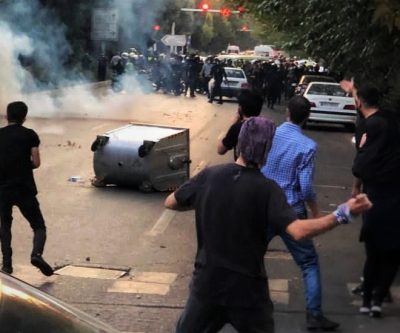by Jeremy Kuzmarov, Global Research:

In late September, protests erupted in Iran following the death of a 22-year-old Kurdish woman, Mahsa Amini, after she had been arrested by morality police in Tehran purportedly for not wearing the hijab.
Amini died allegedly of a cerebral hemorrhage or stroke after, eyewitnesses claimed, she was beaten while incarcerated.
The Iranian government, however, released a video which appeared to show that Amini merely got in a dispute with a police officer about the way she wore the hijab and that the police officer walked away.
Amini subsequently collapsed in the Tehran police station and died two days later after having a heart attack allegedly caused by prior health problems (Amini allegedly underwent open brain surgery as a child in 2006).[1]
TRUTH LIVES on at https://sgtreport.tv/
U.S. President Joe Biden was very supportive of the protests from the outset, announcing intensified sanctions on Iran while assigning restrictions on the export of software and hardware to make it easier for Iranians to communicate with each other and the outside world.
Biden said that he was “gravely concerned about reports of the intensifying violent crackdown on peaceful protesters in Iran, including students and women, who are demanding their equal rights and basic human dignity,” and that for decades “Iran’s regime has denied fundamental freedoms to its people and suppressed the aspirations of successive generations through intimidation, coercion and violence.”
Are Iranian Leaders Paranoid?
Iran’s president, Ebrahim Raisi, claimed that outside forces led by the U.S. had ignited the protests and were trying to bring down the Iranian regime.
The Iranian government was particularly vulnerable because of severe economic problems—caused in no small part by U.S. sanctions—and reports about the declining health of Supreme Leader Ayatollah Ali Khamenei, who is allegedly making preparations for his son, Mojtaba, to succeed him and sustain Iran’s commitment to Islamic ideology.
The U.S. has a track record of supporting regime-change operations like in Libya, Syria and Iraq among other countries.
The CIA also orchestrated a coup in Iran in 1953 that resulted in the overthrow of democratic reformer Mohammad Mosaddegh and installed the pro-Western Shah who terrorized his opposition and enabled foreign control of Iran’s oil industry.
That 1953 coup significantly started when the CIA paid off gangs and labor leaders to initiate protests against Mosaddegh.
Since the 1979 Iranian Revolution that overthrew the Shah, the U.S. has repeatedly tried to overthrow the Iranian government, which famously took U.S. Embassy officials hostage and frequently supported U.S. adversaries such as Hezbollah; the Houthi in Yemen; the Palestinians; and the Assad government in Syria.[2]
In 2007, President George W. Bush openly endorsed a CIA plan for propaganda and disinformation targeting Iran, and approved the mounting of black operations designed to destabilize Iran’s government.
The Obama administration followed suit by a) encircling Iran with missiles placed in Qatar, Bahrain, Kuwait and the United Arab Emirates (UAE); b) strengthening Bush’s economic sanctions and pushing Saudi Arabia to drive up its oil production to push oil prices down; and c) removing the Mujahedin e-Khalq—a dissident group that plotted sabotage operations against the Iranian government—from the State Department’s list of terrorist groups.[3]
The Trump administration ratcheted up sanctions even further and assassinated General Qasem Soleimani, famed commander of the Quds force, an elite unit of the Iranian Revolutionary Guard.
So Iranian leaders clearly are not paranoid in believing that the U.S. is behind the recent protests.
Syria, Libya, Ukraine Redux?
Many Iranian women have come out to voice their opposition to the mandatory veil—a measure the majority of Iranians actually support.[4]
As in other “color revolutions,” legitimate grievances can be easily exploited by outside forces and protests can quickly become violent and dominated by extremists bent on regime change.
Images have filled social media of Iranian protesters waving signs such as “death to the dictator” amidst a backdrop of burning cars. One video showed a crowd defacing a billboard depicting Qasem Soleimani, a national hero.




